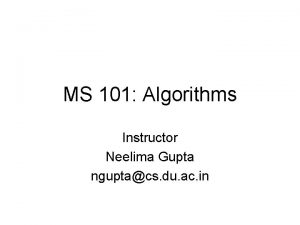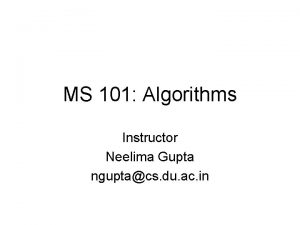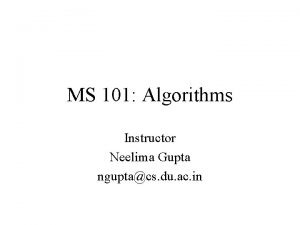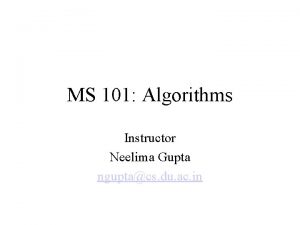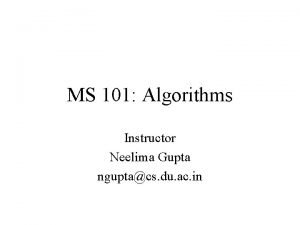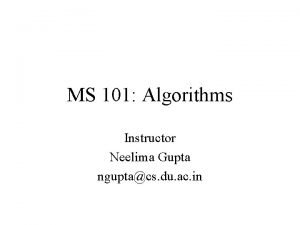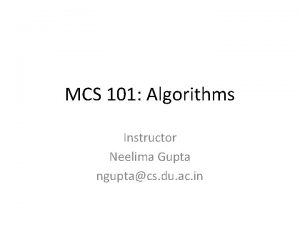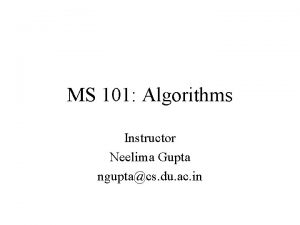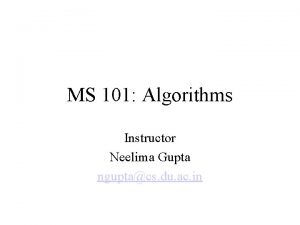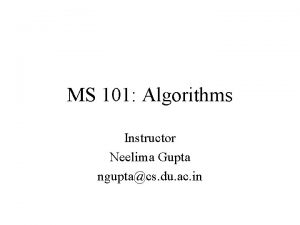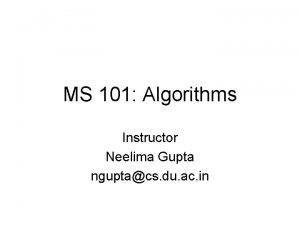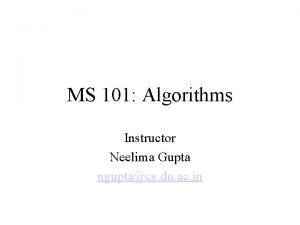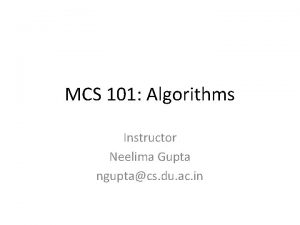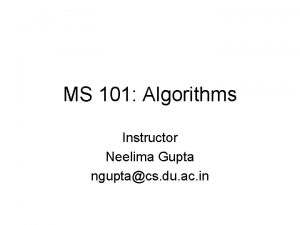MS 101 Algorithms Instructor Neelima Gupta nguptacs du





![Proving the Hypothesis by induction • Base Case : H[1] is true vacuously. • Proving the Hypothesis by induction • Base Case : H[1] is true vacuously. •](https://slidetodoc.com/presentation_image/1af21390a15292111b4da6ccf4ca61e1/image-6.jpg)












![Proof of Induction Hypothesis contd. . b: ) When L[(fk + lk)/2] >x then Proof of Induction Hypothesis contd. . b: ) When L[(fk + lk)/2] >x then](https://slidetodoc.com/presentation_image/1af21390a15292111b4da6ccf4ca61e1/image-19.jpg)
![Proof of Induction Hypothesis contd. . b: ) When L[(fk + lk)/2] >x then Proof of Induction Hypothesis contd. . b: ) When L[(fk + lk)/2] >x then](https://slidetodoc.com/presentation_image/1af21390a15292111b4da6ccf4ca61e1/image-20.jpg)



- Slides: 23

MS 101: Algorithms Instructor Neelima Gupta ngupta@cs. du. ac. in

Table Of Contents Proving Correctness of Algorithms

Proving the correctness of Algorithm • Sequential Search • 1. index = 1; 2. While index ≤ n and L[index] ≠ x do index = index + 1; 3. if index > n then index = 0;

Defining the I/O of the algorithm • Input : Given an array L containing n items (n ≥ 0) and given x, • Output: – the sequential search algorithm terminates – with index = first occurrence of x in L, if found – and, index = 0 otherwise.

Loop Invariant • Hypothesis: For 1 ≤ k ≤ n + 1, L(k): when the control reaches the test in line 2 for kth time – index = k and, – for 1 ≤ i ≤ k-1, L[i] ≠ x. • Prove the above hypothesis by induction
![Proving the Hypothesis by induction Base Case H1 is true vacuously Proving the Hypothesis by induction • Base Case : H[1] is true vacuously. •](https://slidetodoc.com/presentation_image/1af21390a15292111b4da6ccf4ca61e1/image-6.jpg)
Proving the Hypothesis by induction • Base Case : H[1] is true vacuously. • Let H(k) be true • We will prove that H(k+1) is also true.

control reaches the test in line 2 for (k+1)th time only if L(k) ≠ x …………. …. . (i) Also since H(k) is true 1 ≤ i ≤ k-1, L[i] ≠ x …………. . (ii) from (i) and (ii) we get, 1 ≤ i ≤ k, L[i] ≠ x ·˙· it holds for index = k+1 Thus by induction our hypothesis is true.

Correctness contd. . • Suppose the test condition is executed exactly k times. i. e. body of the loop is executed k-1 times. – Case 1: k = n+1, by loop invariant hypothesis, index = n+ 1 and for 1 ≤ i ≤ n, L[i] ≠ x. Since index = n+ 1, line 3 sets index to 0 and by secondition above x is not in the array. So correct. – Case 2: k ≤ n, => index =k and loop terminated because L[k] = x. Thus index is the position of the first occurrence of x in the array. Hence the algorithm is correct in either case.

Binary Search • Input : Given an array L containing n items (n ≥ 0) ordered such that L(1) <= L(2) <= L(3) <=… <=L(n) and given x, • Output: The binary search algorithm terminates – with index = an occurrence of x in L, if found – and, index = 0 otherwise. Binary search can only be applied if the array to be searched is already sorted.

Search for the no. 15 1 10 15 20 25 30 35 45 50

Search for the no. 30 1 10 15 20 25 30 35 45 50 30

1. index_first = 1; 2. index_last=n; 3. While index_first<=index_last do 4. index_mid= floor((index_first+index_last)/2); 5. if L[index_mid]=x 6. Exit loop 7. if L[index_mid]>x 8. index_last=index_mid-1; 9. if L[index_mid]<x 10. index_first=index_mid+1; 11. 12. If index_first>index_last then 13. index_mid=0;

Proof of correctness The Loop Invariant Let r be the maximum number of times the loop starting from line 3 will run. • Hypothesis: For 1 ≤ k ≤ r + 1, H(k): when the control reaches the test in line 3 for kth time – L[i] ≠ x for every i<first & for every i>last • Prove the above hypothesis by induction

Correctness of the algorithm assuming the hypothesis (the loop invariant) Suppose the test condition is executed t times. – Case 1: first<=last. We exit from the loop because L[mt]=x. Thus, mid is a position of occurrence of x as mid=mt. – Case 2: If first>last, we exit from the loop starting at line 3. Line 13 sets the value of mid to 0 since first>last. By loop invariant hypothesis, for i<first and i>last, L[i] ≠ x i. e. x is not found in the array. The algorithm correctly returns 0 in mid. Hence assuming that the statement H(k) is correct the algorithm works correctly.

Proof of Induction Hypothesis Let fi and li be the values of first and last when the test condition at line 3 is executed for the ith time with f 1 and l 1 being 1 and n respectively. • Assume that the statement is true for H(k) • We will prove that it is true for H(k+1) In the kth iteration either first was set to (fk + lk)/2 +1 i. e. fk+1 = (fk + lk)/2 +1 or last was set to (fk + lk)/2 -1 i. e lk+1 = (fk + lk)/2 -1

Proof of Induction Hypothesis contd. . • Case 1: fk+1 > lk+1( only if fk = lk and L[(fk + lk)/2] ≠ x) By induction hypothesis L[i] ≠ x i< fk L[i] ≠ x i> lk (= fk) And, also L[fk ] = L[(fk + lk)/2] ≠ x So x is not present, hence trivially L[i] ≠ x i< fk+1 L[i] ≠ x i> lk+1 Thus H(k+1) is true.

Proof of Induction Hypothesis contd. . Case 2: fk+1 <= lk+1 a: ) when L[(fk + lk)/2] <x then fk+1 = (fk + lk)/2 +1 i< fk +1, L[i] ≤ L[(fk + lk)/2]<x (Why? )

Proof of Induction Hypothesis contd. . Case 2: fk+1 <= lk+1 a: ) when L[(fk + lk)/2] <x then fk+1 = (fk + lk)/2 +1 i< fk +1, L[i] ≤ L[(fk + lk)/2]<x (input is sorted) i. e. L[i] ≠ x i<= fk+1 – 1 or I < fk+1 Also, by induction hypothesis L[i] ≠ x i> lk(= lk+1)
![Proof of Induction Hypothesis contd b When Lfk lk2 x then Proof of Induction Hypothesis contd. . b: ) When L[(fk + lk)/2] >x then](https://slidetodoc.com/presentation_image/1af21390a15292111b4da6ccf4ca61e1/image-19.jpg)
Proof of Induction Hypothesis contd. . b: ) When L[(fk + lk)/2] >x then lk+1 =(fk + lk)/2 -1 i> lk+1 , L[i] ≥ L[(fk + lk)/2]>x (Why? ) i. e. L[i] ≠ x i> lk+1
![Proof of Induction Hypothesis contd b When Lfk lk2 x then Proof of Induction Hypothesis contd. . b: ) When L[(fk + lk)/2] >x then](https://slidetodoc.com/presentation_image/1af21390a15292111b4da6ccf4ca61e1/image-20.jpg)
Proof of Induction Hypothesis contd. . b: ) When L[(fk + lk)/2] >x then lk+1 =(fk + lk)/2 -1 i> lk+1 , L[i] ≥ L[(fk + lk)/2]>x (Why? ) i. e. L[i] ≠ x i> lk+1 Also, by induction hypothesis L[i] ≠ x i< fk+1(= fk) Hence H(k+1) is true. This proves that our hypothesis is correct

Assignment 5 • Show that Insertion sort works correctly by using Induction.

Up Next Introduction to some tools to designing algorithms through Sorting

The End
 Neelima gupta delhi university
Neelima gupta delhi university Neelima balakrishnan
Neelima balakrishnan Bogajkoi
Bogajkoi Basic instructor course #1014
Basic instructor course #1014 Basic instructor course #1014
Basic instructor course #1014 Utp cable
Utp cable Basic instructor course texas
Basic instructor course texas Instructor operating station
Instructor operating station Instructor vs teacher
Instructor vs teacher Jrotc marksmanship instructor course online
Jrotc marksmanship instructor course online Please clean the room before you live
Please clean the room before you live Tcole 1014 basic instructor course
Tcole 1014 basic instructor course Basic instructor course texas
Basic instructor course texas Basic instructor course tcole
Basic instructor course tcole Cbrf registry wi
Cbrf registry wi Basic instructor course texas
Basic instructor course texas Catia instructor
Catia instructor Cisco certified instructor
Cisco certified instructor Ames room
Ames room Tcole advanced instructor course
Tcole advanced instructor course Tipos de participantes en un curso
Tipos de participantes en un curso Njrotc instructor vacancies
Njrotc instructor vacancies Nfpa 1403
Nfpa 1403 Virtual instructor art
Virtual instructor art
